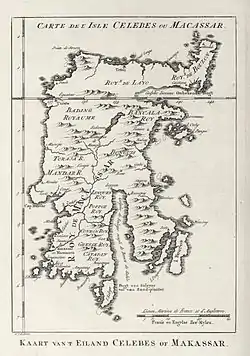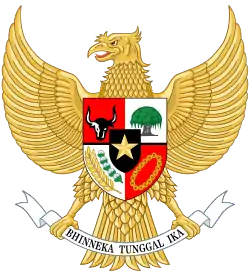Luwu
The Kingdom of Luwu (also Luwuq or Wareq) is generally thought to be the oldest kingdom in South Sulawesi. In 1889, the Dutch Governor of Makassar placed Luwu's heyday between the 10th and 14th centuries, but offered no evidence. The La Galigo, an epic poem composed in a literary form of the Bugis language, is the likely inspiration of Braam Morris’ dating. The La Galigo depicts a vaguely defined world of coastal and riverine kingdoms whose economies are based on trade. Two early centres of this world are Luwu and the kingdom of Cina (pronounced Cheena) in what is now Wajo. The incompatibility of the La Galigo's trade-based political economy with the agricultural economies of other South Sulawesi kingdoms has led scholars to posit an intervening period of chaos to separate the two societies chronologically.[1]
Luwu ᨒᨘᨓᨘ | |
|---|---|
 | |
| Status | Part of Indonesia |
| Capital | Palopo after c.1620 |
| Common languages | Bugis |
| Religion | Sunni Islam after 1605 |
| Government | Monarchy |
| Datu | |
| Currency | No official currency, the Barter system was used |
| Today part of | (as Luwu Regency) |
Part of a series on the |
|---|
| History of Indonesia |
   |
| Timeline |
|
|
Archaeological and textual research carried out since the 1980s has undermined this chronology.[2] Extensive surveys and excavations in Luwu have revealed that the Bugis-speaking kingdom is a century or so younger than the oldest polities of the southwest peninsula.[3] The earliest textual reference to Luwu is in the East Javanese court poem Desawarnana, dated 1365, which lists Luwu, Bantaeng and Uda (possibly Cina) as the three major powers on the peninsula. However, there is no convincing archaeological evidence of Bugis settlement in Luwu before c.1300 CE.
The new understanding is that Bugis speaking settlers from the western Cenrana valley began to settle along the coastal margins of Luwu around the year 1300 CE. The Gulf of Bone is not a Bugis-speaking area: it is a thinly populated region of great ethnic diversity in which Bugis speakers are a minority Speakers of Pamona, Padoe, Wotu and Lemolang languages live on the coastal lowlands and foothills, while the highland valleys are home to groups speaking other Central and South Sulawesi languages. The Bugis are found almost solely along the coast, to which they have evidently migrated in order to trade with Luwu's indigenous peoples. It is clear both from archaeological and textual sources that Luwu was a Bugis-led coalition of various ethnic groups, united by trading relationships and the ability of the Datu (ruler) of Luwu to enforce peace among neighbouring hill tribes. The main centres of Bugis settlement were (and still are) Bua, Ponrang, Malangke, and Cerekang near Malili.
The migration of Bugis from the central lakes area to Luwu was evidently lead by members of Cina's ruling family, a loose coalition of high-ranking families claiming a common ancestry that ruled settlements across the Cenrana and Walennae valleys. This can be surmised from the fact that Luwu and Cina share the same founding myth of a tomanurung or heavenly-decended being called Simpurusia, and that both versions of this myth state that Simpurusia descended at Lompo, in Sengkang. Cina was absorbed in the 16th century by its former tributaries of Soppeng and Wajo, after which its ruling family effectively vanished. However, the ancient line of Cina's rulers continued in Luwu until the abolition of kingdoms in 1954. It is likely that the widespread belief that Luwu is older than other South Sulawesi kingdoms stems partly from this illustrious lineage and accounts for the precedence today of the Datu Luwu over all the former ruling families of South Sulawesi.
Luwu's political economy was based on the smelting of iron ore brought down, via the Lemolang-speaking polity of Baebunta, to Malangke on the central coastal plain. The smelted iron was worked into weapons and agricultural tools and exported to the rice-growing southern lowlands. This brought the kingdom great wealth, and by the mid-14th century Luwu had become the feared overlord of large parts of the southwest and southeast peninsula. The earliest identifiable ruler is Bataraguru (mid-15th century) whose name appears in a peace treaty with Bone. However, the first ruler for which we have any detailed information was Dewaraja (ruled c. 1495-1520). Stories current today in South Sulawesi tell of his aggressive attacks on the neighboring kingdoms of Wajo and Sidenreng. Luwu's power was eclipsed in the 16th century by the rising power of the southern agrarian kingdoms, and its military defeats are set out in the Chronicle of Bone.
On 4 or 5 February 1605, Luwu's ruler, La Patiwareq, Daeng Pareqbung, became the first major South Sulawesi ruler to embrace Islam, taking as his title Sultan Muhammad Wali Mu’z’hir (or Muzahir) al–din. La Patiwareq is buried at Malangke and is referred to in the chronicles as Matinroe ri Wareq, ‘He who sleeps at Wareq’, the former palace–centre of Luwuq. His religious teacher, Dato Sulaiman, is buried nearby. Around 1620, Malangke was abandoned and a new capital was established to the west at Palopo. It is not known why this sprawling settlement, the population of which may have reached 15,000 in the 16th century, was suddenly abandoned: possibilities include religious turmoil, the declining price of iron goods and the economic potential of trade with the Toraja highlands.
By the 19th century, Luwu had become a backwater. James Brooke, later Rajah of Sarawak, wrote in the 1830s that ‘Luwu is the oldest Bugis state, and the most decayed [...] Palopo is a miserable town, consisting of about 300 houses, scattered and dilapidated [...] It is difficult to believe that Luwu could ever have been a powerful state, except in a very low state of native civilisation.’[4] In the 1960s Luwu was a focus of an Islamic rebellion led by Kahar Muzakkar. Today the former kingdom is home to the world's largest nickel mine and is experiencing an economic boom fueled by inward migration, yet it still retains much of its original frontier atmosphere.
See also
References
- Pelras, C. 1996. The Bugis. Oxford: Blackwell.
- Bulbeck, D. and I. Caldwell. 2000. Land of iron; The historical archaeology of Luwu and the Cenrana valley. Hull: Centre for South East Asian Studies, University of Hull.
- David Bulbeck and Ian Caldwell, Land of iron: The historical archeology of Luwu and the Cenrana valley. Results of the Origins of Complex Society in South Sulawesi Project (OXIS). Centre for South-East Asian Studies Occasional Publications Series, University of Hull.
- Brooke, J. 1848. Narrative of events in Borneo and Celebes down to the occupation of Labuan. From the Journals of James Brooke, Esq. Rajah of Sarawak and Governor of Labuan [. . .] by Captain Rodney Mundy. London: John Murray.